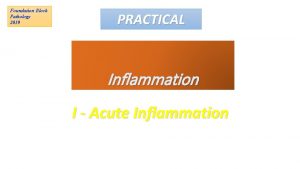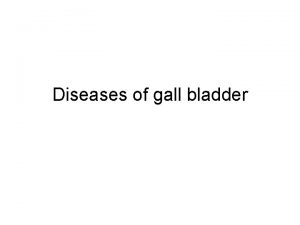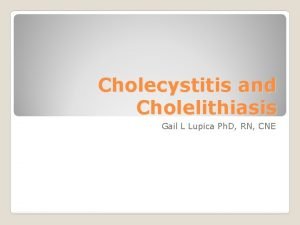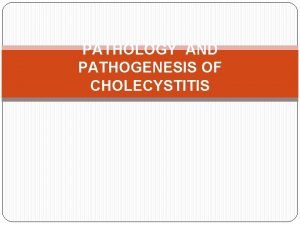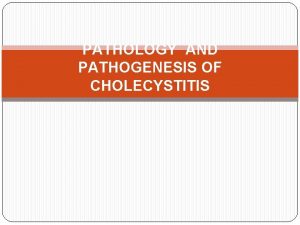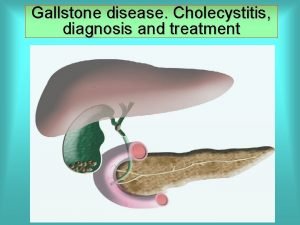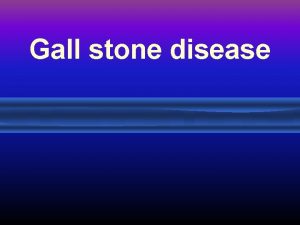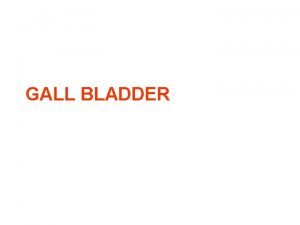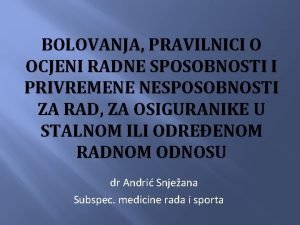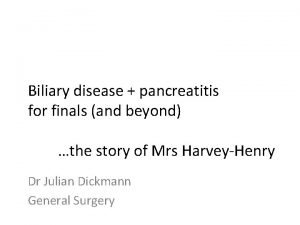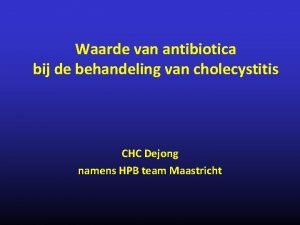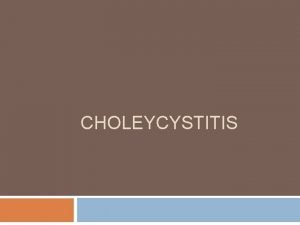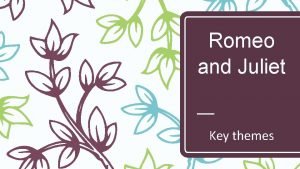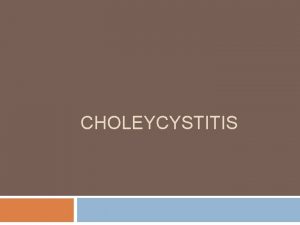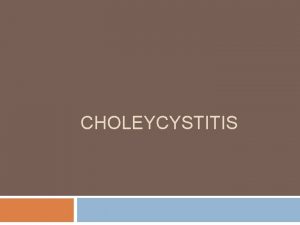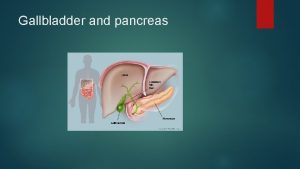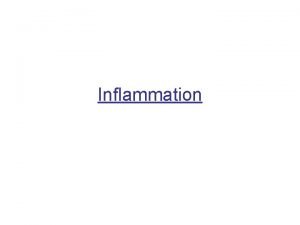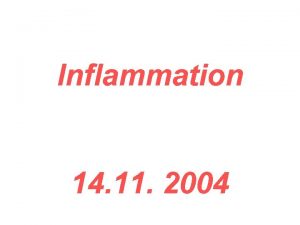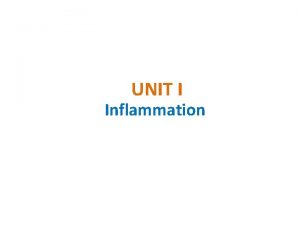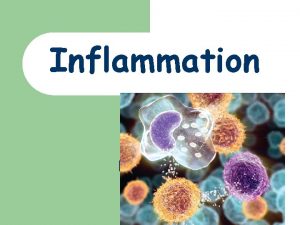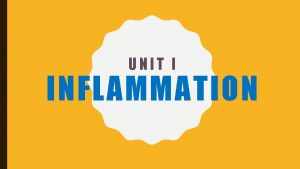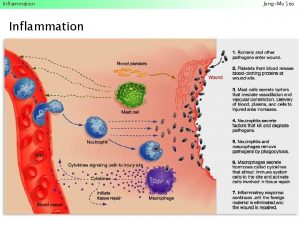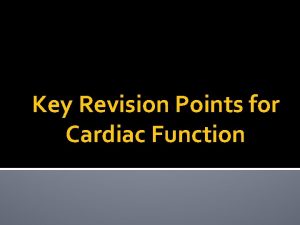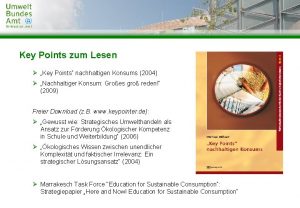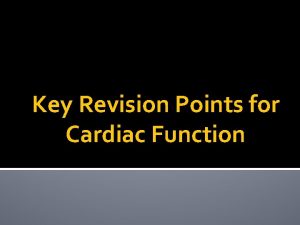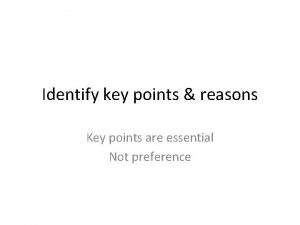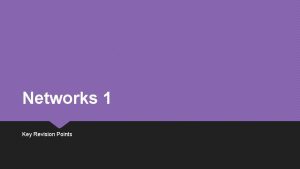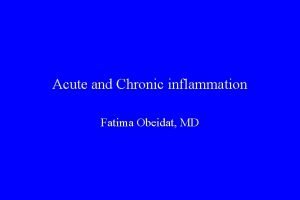CHOLEYCYSTITIS Key points Cholecystitis is an inflammation of



















- Slides: 19

CHOLEYCYSTITIS

Key points Cholecystitis is an inflammation of the gallbladder wall. The “attack” usually subsides in 2 to 3 days. Bile is used for the digestion of fats. It is produced in the liver and stored in the gall bladder. Cholecystitis can be acute or chronic, and it can also obstruct the pancreatic duct. Cholecystitis is most often caused by gallstone (cholelithiasis) obstructing the cystic and/or common bile ducts (bile flow from gallbladder to duodenum); cholecystitis without gallstones is rare and serious.

Key points Calculi usually form in the gallbladder from solid constituents of bile and vary greatly in: size, shape, and composition. There are two major types of gallstones: � pigment stones, which contain an excess of unconjugated pigments in the bile, and � cholesterol stones (the more common form), which result from bile supersaturated with cholesterol due to increased synthesis of cholesterol and decreased synthesis of bile acids that dissolve cholesterol.

Key points Most clients with cholecystitis have gallstones (calculous cholecystitis). A gallstone obstructs bile outflow and bile in the gallbladder initiates a chemical reaction, resulting in edema, compromise of the vascular supply, and gangrene. Cholecystitis (acalculous? ? ? ) may occur after surgery, severe trauma, or burns, cystic duct obstruction, multiple blood transfusions, and primary bacterial infections of the gallbladder. Infection causes pain, tenderness, and rigidity of the RUQ and is associated with N & V and the usual signs of inflammation. Purulent fluid indicates an empyema

Risk Factors More common in females Obesity (impaired fat metabolism, high cholesterol levels) Multiparus Older than 40 years of age (more likely to develop gallstones) 4 Fs High-fat diet Pills; estrogen Genetic predisposition Individuals with type 1 diabetes mellitus (high triglycerides) Low-calorie, liquid protein diets Rapid weight loss (increases cholesterol)

Risk Factors Risk factors for pigment stones include: cirrhosis, � hemolysis, and � infections of the biliary tract. � These stones cannot be dissolved and must be removed surgically.

Triggering Factors Trauma Surgery Coronary events Diabetes Fasting Immobility Hormone replacement therapy (HRT) Pregnancy

Diagnostic Procedures and Nursing Interventions RUQ US is the most diagnostic. Visualizes gallbladder edema. Cholecystogram, cholangiogram; celiac axis arteriography Abdominal x-ray (may visualize calcified gallstones) WBCs elevations Direct (normal is 0. 1 to 0. 3 mg/d. L), indirect (0. 2 to 0. 8 mg/d. L), and total (0. 1 to 1. 0 mg/d. L) serum bilirubin levels (elevated if obstruction) Aspartate aminotransferase (AST) and lactate dehydrogenase (LDH) (elevated if liver dysfunction) Serum cholesterol (elevated above 200 mg/d. L) Hepatobiliary scan (assesses patency of biliary duct system)

Therapeutic Procedures and Nursing Interventions Medical Management Major objectives of medical therapy are to reduce the incidence of acute episodes of gallbladder pain and cholecystitis by: supportive and dietary management and, if possible, � remove the cause by pharmacotherapy, endoscopic procedures, or surgical intervention. �

Therapeutic Procedures and Nursing Interventions Cholecystectomy – with a laparoscopic or an open approach (when exploration of biliary ducts is indicated). Postoperatively, clients may experience free air pain following laparoscopic surgery. Ambulation is helpful. Following an open approach, nursing care includes monitoring drainage from inserted Jackson-Pratt (JP) drains and T-tube.

Therapeutic Procedures and Nursing Interventions Nonsurgical Removal of Gallstones In addition to dissolving gallstones, they can be removed by other instrumentation (eg, catheter and instrument with a basket attached are threaded through the T-tube tract or fistula formed at the time of T-tube insertion, ERCP endoscope), intracorporeal lithotripsy (laser pulse), or extracorporeal shock wave therapy(lithotripsy or extracorporeal shock wave lithotripsy [ESWL]).

Assessments May be silent, producing no pain and only mild GI symptoms May be acute or chronic with epigastric distress (fullness, abdominal distention, and vague URQ); may follow a meal rich in fried or fatty foods An attack of cholecystitis “gallbladder attack” is characterized by: � Sharp pain in the RUQ of the abdomen, often radiating to the RT shoulder. � Pain with deep inspiration during right subcostal palpation (Murphy’s sign). � Intense pain (tachycardia, pallor, diaphoresis) after ingestion of a large quantity of high-fat food.

Assessments Rebound tenderness. Nausea, anorexia, and vomiting. Dyspepsia, eructation (belching), and flatulence. Fever Jaundice, clay-colored stools, dark urine, steatorrhea (fatty stools), and pruritus may be seen in clients with chronic cholecystitis (due to biliary obstruction). Deficiencies of vitamins A, D, E, and K (fat-soluble vitamins)

NANDA Nursing Diagnoses Acute pain Impaired gas exchange Risk for infection Impaired skin integrity Imbalanced nutrition, less than body requirements, Deficient knowledge

Nursing Interventions Achieve remission with rest, IV fluids, nasogastric suction, analgesia, and antibiotics. Dietary Counseling Encourage a low-fat diet (reduced dairy; avoid fried foods, eggs, cream, chocolate, cheese, rich dressings, nuts, and gravies). � high protein and carbohydrates � Promote weight reduction. � Fat-soluble vitamins and bile salts may be prescribed if obstruction is present to enhance absorption and aid digestion. � Avoid gas-forming foods (beans, cabbage, cauliflower, broccoli). � Smaller, more frequent meals may be tolerated better �

Nursing Interventions Administer analgesics as needed and prescribed Meperidine (Demerol) is generally preferred over morphine) Antispasmodics and anticholinergics Antiemetics Postoperative Care � Support pain management. � Encourage splinting to reduce pain. � Encourage measures to reduce risk of respiratory complications � Monitor wound incision(s) and provide wound care. � Monitor and record T-tube drainage (initially bloody, then greenbrown bile). � Initially, may drain > 400 m. L/day and then gradually decreases in amount.

Nursing Interventions Report sudden increases in drainage or amounts exceeding 1, 000 m. L/day. Inspect surrounding skin. Maintain flow by gravity. Clamp 1 to 2 hr ac and pc. Monitor and document the client’s response to food. Client Education � Activity precautions 4 to 6 weeks � Care of T-tube (up to 6 weeks postoperatively) – Report sudden increase in drainage or foul odor; Clamp 1 to 2 hr before and after meals. � Stool color should return to brown color in about a week. � Encourage a low-fat diet.

Surgical Terms Laparoscopic cholecystectomy: performed through a small incision or puncture made through the abdominal wall in the umbilicus. Cholecystectomy: Gallbladder is removed through an abdominal incision (usually right subcostal) after ligation of the cystic duct and artery. Minicholecystectomy: Gallbladder is removed through a small incision. Choledochostomy: incision into the common duct for stone removal. Cholecystostomy (surgical or percutaneous): Gallbladder is opened, and the stone, bile, or purulent drainage is removed.

Complications and Nursing Implications Obstruction of the bile duct can cause ischemia and a rupture of the gallbladder wall is possible. Rupture of the gallbladder wall can cause a local abscess or peritonitis (rigid, board-like abdomen, guarding), which requires surgical intervention and administration of broad spectrum antibiotics.
 Acute cholecystitis vs chronic cholecystitis
Acute cholecystitis vs chronic cholecystitis Hyperplasia
Hyperplasia Choleycystitis
Choleycystitis Pathogenesis of cholecystitis
Pathogenesis of cholecystitis Cholecystitis pathogenesis
Cholecystitis pathogenesis Perbedaan cholelithiasis dan cholecystitis
Perbedaan cholelithiasis dan cholecystitis Gallstone anatomy
Gallstone anatomy Pathophysiology of cholelithiasis ppt
Pathophysiology of cholelithiasis ppt Cholecystitis chr calculosa
Cholecystitis chr calculosa Cholecystitis pathophysiology
Cholecystitis pathophysiology Richtlijn cholecystitis
Richtlijn cholecystitis Chronic pancreatitis nursing care plan
Chronic pancreatitis nursing care plan Cholecystitis nursing interventions
Cholecystitis nursing interventions Brand positioning bulls eye
Brand positioning bulls eye Points of parity and points of difference
Points of parity and points of difference Business model canvas covid 19
Business model canvas covid 19 Key partners
Key partners Romeo and juliet plot timeline
Romeo and juliet plot timeline Romeo and juliet pee paragraphs
Romeo and juliet pee paragraphs Romeo and juliet theme
Romeo and juliet theme
